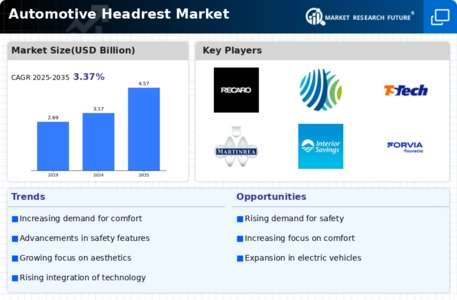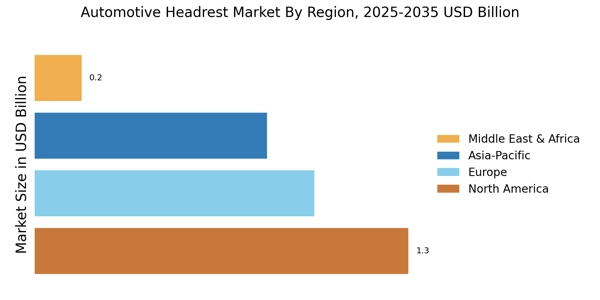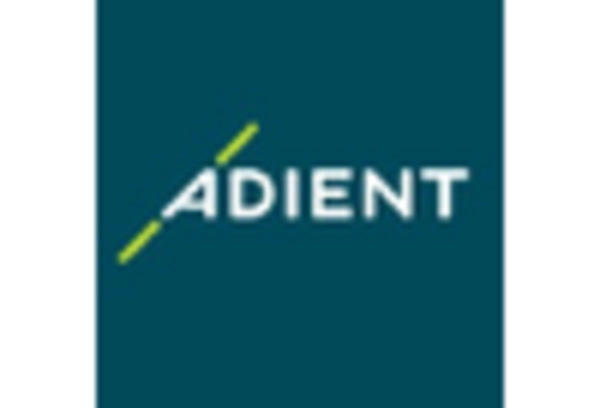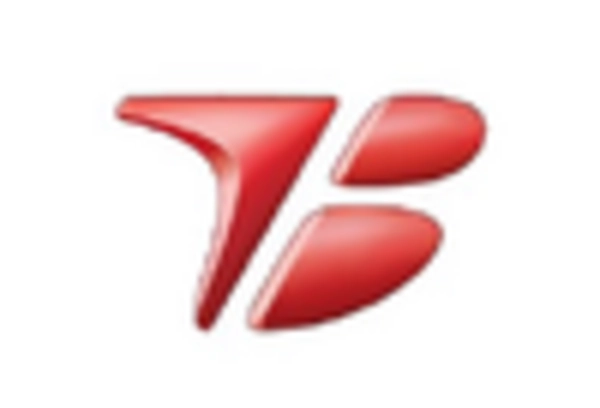Consumer Preference for Customization
The Automotive Headrest Market is increasingly shaped by consumer preferences for customization and personalization. As vehicle buyers seek unique features that reflect their individual tastes, manufacturers are responding by offering a variety of headrest designs, materials, and functionalities. This trend is particularly evident in the luxury vehicle segment, where bespoke options are becoming standard. Market analysis indicates that the luxury automotive segment is anticipated to grow at a rate of 7% annually, further emphasizing the need for tailored headrest solutions. By catering to these preferences, the Automotive Headrest Market can enhance customer satisfaction and loyalty, ultimately driving sales and market share.
Rising Demand for Vehicle Safety Features
The Automotive Headrest Market experiences a notable surge in demand for enhanced vehicle safety features. As consumers become increasingly aware of the importance of safety in automotive design, manufacturers are compelled to innovate. Headrests play a crucial role in preventing whiplash injuries during collisions, leading to a growing emphasis on their design and functionality. According to recent data, the market for automotive safety features is projected to grow at a compound annual growth rate of approximately 6.5% over the next five years. This trend indicates that the Automotive Headrest Market must adapt to meet the evolving safety standards and consumer expectations, thereby driving innovation and investment in headrest technology.
Sustainability and Eco-Friendly Materials
Sustainability initiatives are becoming a pivotal driver in the Automotive Headrest Market, as manufacturers increasingly prioritize eco-friendly materials and production processes. The growing consumer demand for sustainable products is prompting companies to explore alternatives to traditional materials, such as recycled plastics and organic fabrics. This shift not only aligns with global environmental goals but also enhances brand reputation among eco-conscious consumers. Market Research Future indicates that the sustainable automotive materials market is projected to grow at a rate of 8% annually, reflecting a broader trend towards sustainability in the automotive sector. Consequently, the Automotive Headrest Market must adapt to these changes to remain competitive and relevant in an evolving marketplace.
Regulatory Compliance and Safety Standards
The Automotive Headrest Market is significantly influenced by stringent regulatory compliance and safety standards imposed by various authorities. Governments worldwide are increasingly mandating higher safety requirements for vehicles, which directly impacts headrest design and functionality. Compliance with these regulations not only ensures consumer safety but also enhances the marketability of automotive products. Recent legislative changes have introduced more rigorous testing protocols for headrests, compelling manufacturers to invest in research and development. This focus on compliance is expected to drive growth in the Automotive Headrest Market, as companies strive to meet or exceed these evolving standards, thereby fostering innovation and improving product offerings.
Technological Advancements in Automotive Design
Technological advancements significantly influence the Automotive Headrest Market, as manufacturers increasingly integrate innovative materials and designs. The introduction of adjustable and memory foam headrests enhances comfort and support, catering to diverse consumer preferences. Furthermore, the incorporation of smart technology, such as sensors that monitor driver posture, is gaining traction. This shift towards advanced headrest solutions aligns with the broader trend of vehicle automation and connectivity. Market data suggests that the automotive technology sector is expected to reach a valuation of over 800 billion dollars by 2026, indicating a robust growth trajectory. Consequently, the Automotive Headrest Market must leverage these advancements to remain competitive and relevant.


















Leave a Comment